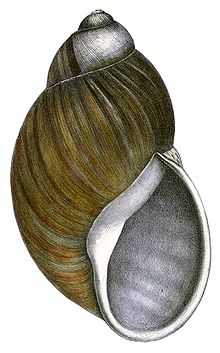Megalobulimus popelairianus
| Megalobulimus popelairianus | |
|---|---|
 | |
| Drawing of a shell of Megalobulimus popelairianus. | |
| Scientific classification | |
| Kingdom: | Animalia |
| Phylum: | Mollusca |
| Class: | Gastropoda |
| (unranked): | clade Heterobranchia clade Euthyneura |
| Superfamily: | Acavoidea |
| Family: | Strophocheilidae |
| Subfamily: | Megalobuliminae |
| Genus: | Megalobulimus |
| Species: | M. popelairianus |
| Binomial name | |
| Megalobulimus popelairianus (Nyst, 1845) | |
| Synonyms | |
|
Strophocheilus popelairianus | |
Megalobulimus popelairianus,[1] synonym Strophocheilus popelairianus, is a species of tropical air-breathing land snail, a terrestrial pulmonate gastropod mollusk in the family Strophocheilidae.
Distribution
Megalobulimus popelairianus occurs in Ecuador, in Bolivia (doubtful)[2] and in Brazil.[1]
Shell description
The shell is very large, solid, rimate, ovate-conic. The spire is subregularly tapering and the penultimate whorl is somewhat bulging. The last whorl is depressed on the back. The color of the shell is dark reddish-brown or rich chestnut with narrow darker streaks and a lighter margin below the suture. The earlier whorls are dull reddish. The apex is white. The surface is covered with a strong cuticle, shining. Nepionic shell is distinctly marked, with 4 whorls, sculptured with strong narrow radial riblets, which on fourth whorl become obsolete toward suture below. Succeeding whorls 2, having growth-wrinkles and a dense but rather irregular spiral granulation which fades out upon last whorl, which is more coarsely sculptured by lengthwise wrinkles and has generally more or less- coarse spiral malleation. Sutures are deep, the last decidedly more oblique.[2]
The aperture is about half the shell's length, trapezoidal, white with a livid tint within. Outer lip is well reflexed, white (or light-brown edged), convexly curved. Columella is white, reflexed, and in the immediate vicinity of its insertion spreading upon the whorl and continued in a strong white callus across the parietal wall. Near the upper termination of parietal callus there are usually one or two low callous nodules.[2]
The width of the adult shell varies from 85 to 98 mm, the height from 136–155 mm.[2]
Eggs
Megalobulimus popelairianus has the largest eggs of all land gastropods. The size of the egg is 51 × 35 mm[3] (see also Stanlen 1917).
References
This article incorporates public domain text from reference.[2]
- ↑ 1.0 1.1 Norma Campos Salgado & Arnaldo C. dos Santos Coelho. 2003. Moluscos terrestres do Brasil (Gastrópodes operculados ou não, exclusive Veronicellidae, Milacidae e Limacidae). Rev. Biol. Trop. 51 (Suppl. 3): 149-189, page 158. (in Portuguese with English abstract)
- ↑ 2.0 2.1 2.2 2.3 2.4 Henry Augustus Pilsbry 1895-1896. in George Washington Tryon & Pilsbry H. A. 1895-1896. American Bulimi and Bulimuli. Strophocheilus, Plekocheilus, Auris, Bulimulus Volume 10. Manual of Conchology. Second series: Pulmonata. page 13.
- ↑ Heller J.: Life History Strategies. in Barker G. M. (ed.): The biology of terrestrial molluscs. CABI Publishing, Oxon, UK, 2001, ISBN 0-85199-318-4. 1-146, cited pages: 424-427.
Further reading
Stanlen R. 1917. On the calcareous eggs of terrestrial Mollusca. Journal of Conchology 15: 154-164.